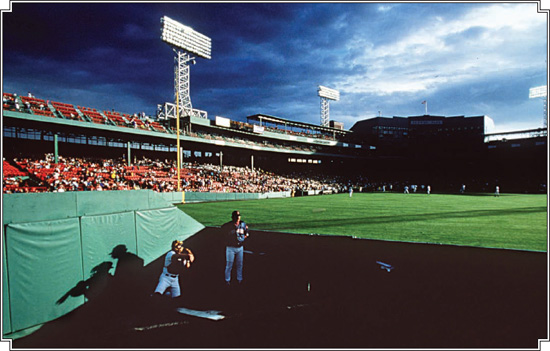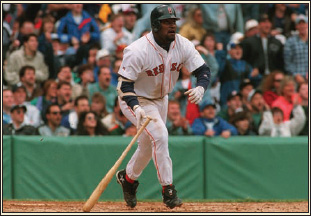Fenway Park (48 page)
Authors: John Powers

TED AND JIMMY TOUCH BASE
He had been a symbol and a secret for a half-century, a New England icon frozen in time, representing all children with cancer. Then, in 1998, the Jimmy Fund logo came to life when Carl Einar Gustafson of New Sweden, Maine, revealed that he was the true “Jimmy.” On July 9, 1999, in a thrill for both of them, he met Ted Williams, the Jimmy Fund’s all-time biggest booster.
Anyone born in New England in the past 50 years knows of this charity dedicated to eradicating cancer in children. In 1948, Gustafson was chosen by Dr. Sidney Farber, the godfather of modern chemotherapy, to represent stricken kids everywhere on a national radio broadcast. They called him “Jimmy” to protect his privacy. The show was a hit, and the Jimmy Fund was launched.
As decades passed and treatments progressed, there was less curiosity about what happened to the original Jimmy. It made sense to assume that the child had died—as did almost all cancer patients of that era. A Maine man to the core, Gustafson never bothered to call attention to his role. “In my day, we were taught to keep things quiet,” he explained. “There really was nothing to say about it. That was bragging.”
In 1997, a year before the 50
th
anniversary of the fund’s launch, Gustafson’s sister sent a letter to Mike Andrews, the fund’s executive director, explaining that her brother was alive and well. “We’d had a lot of leads like this before,” said Andrews, who temporarily set aside the letter. “They were like Elvis sightings.” An investigation based on hospital records and Gustafson’s correspondence with Farber finally convinced Andrews that Gustafson was the real “Jimmy.”
Williams finally met Gustafson when he visited Boston for the All-Star Weekend in 1999. They met at the Dana-Farber Cancer Institute and visited with dozens of patients—people who had a better chance of survival, in part, because of Williams’s tireless efforts, in concert with an army of doctors, nurses, technicians, administrators, and fund-raisers.
“How are you, Jimmy baby?” Williams asked as Gustafson greeted him. “This is the biggest thrill of my trip, right here! Jeez, you look great! You’re an inspiration to everybody!”
Gustafson appeared at numerous functions and recorded public service announcements for the Jimmy Fund. His story was featured in People magazine and Sports Illustrated. As for meeting Williams, he said, “I can’t tell you how proud I feel to have met him.”
Gustafson died in 2001 at age 65 after suffering a stroke.
“After 50 years, to find out he was alive was a miracle,” said Andrews. “Then he turned out to be the most wonderful man. If we had tried to create a Jimmy, we couldn’t have done better. And he was just thrilled to be part of it.”

“Guys like George Will and Bob Costas come in and want to romanticize Fenway Park. But how many times have they had to sit in Section 1, 2, 3, 4, or 5? You sit in sections 6, 7, 8, or 9, you could get a crick in your neck from having to turn to the left all the time; you’re looking straight at center field.”
—Ted Sarandis, Boston radio talk-show host
On Opening Day in 1995, the woman at the center paid a scalper $50 for this obstructed-view seat behind home plate. Today, that would be called a steal.


The Fenway outfield, where the bullpens are located, has always offered a spectacular view of the park.
A day later, Kennedy was gone for good, dismissed by Duquette after taking the fall for his club’s wayward start and its perceived lack of cohesiveness. “It hurts,” said Kennedy, whose players were startled by his firing. “I love what I do and I poured everything I had into it. You can ask the players how much I cared and how much they wanted to do well for me.” By the time successor Jimy Williams arrived, Clemens had filed for free agency and then was gone in December, off to Toronto for what was then the richest contract ($31 million over four years) in baseball history.
When Clemens returned as a Blue Jay on July 12, 1997, after having once vowed that he’d never appear at Fenway in another team’s uniform, he received a decidedly mixed reaction as he strolled out to warm up. Then he blinded his former mates, striking out 16 of them in an overpowering performance that had his former supporters chanting “Roger, Ro-ger.” “He came to make a point and he did,” conceded Vaughn, who whiffed three times.
Clemens—who had been characterized by Duquette upon his departure from the Sox as being in the “twilight of his career”—was jubilant.
“It was a special day, a beautiful day,” said the Rocket, who went on to win the Cy Young Award as the league’s best pitcher. The Sox, who were 17 games out and buried in last place that day, ended up fourth despite having a quintet of .300 hitters, including rookie shortstop Nomar Garciaparra.
The club clearly needed a pitching infusion and Duquette made a trade with his old club for ace Pedro Martinez, who signed a new contract with Boston for six years and $75 million. Martinez won 19 games in his first season in Boston, but it was Vaughn’s bat that set the tone for 1998 with a mighty grand slam that brought his team back from the dead after thousands of discouraged fans had left the premises on Opening Day. “It felt like the World Series,” noted winning pitcher Rich Garcés after the Sox had come from five runs down in the ninth to win, 9-7.
Vaughn, who’d squabbled with management over his salary during the off-season, became a fan favorite with his game-ending shot off Paul Spoljaric. “Sign Mo Now!” fans chanted as he circled the bases. By early May, the club already had come from behind seven times to win in the final inning.
MO’S PUZZLING DEPARTURE
For six seasons, Maurice Samuel “Mo” Vaughn, a native of Norwalk, Connecticut, was the heart and soul of the Red Sox. He twice led the team into the postseason, won an MVP Award and made three All-Star teams. He hit 230 home runs and drove in 752 runs in his tenure with the Sox, and in 1998, the “Hit Dog”—as he came to be known—had a career-best .337 batting average.
But following that 1998 season, Mo was gone, signed away by the Anaheim Angels as the Red Sox made a late, low-ball counteroffer that they had to know would virtually guarantee his departure.
Vaughn’s souring relationship with Sox management had caused it to look past his good work on and off the field.
Mo’s supporters included the Globe’s Bob Ryan, who wrote in July 1998 as the “Should they re-sign Mo?” debate was raging: “Here was a star player—a star player of color, on top of that—who was reflecting glory on the organization because he really was a man in, and of, the community. Central casting couldn’t have shipped over a better player to the Red Sox. And now Mo is the bad guy? Don’t believe it.”
For a long time, Ryan noted, the Sox were eager to tout Vaughn’s standing in Boston and his tireless work with youngsters.
But Vaughn also had gotten into a fight outside a Boston nightclub, and in 1998 he crashed his truck on the way home from a Rhode Island strip club and was arrested for failing field sobriety tests. (He was later tried and found not guilty of drunken driving.) These incidents, along with concerns about Vaughn’s weight, created a growing chorus of Mo detractors.
As the 1998 season went on, his relationship with Sox management deteriorated, and his decision was made for him by the Angels when they made him baseball’s highest-paid player at the time with an $80-million deal.
And though Mo appeared to be on the fast track to Cooperstown when he left the Sox, in the five succeeding seasons, he played just 466 games for the Angels and Mets before injuries forced him to retire.
Still, Vaughn later insisted he had no regrets. “It was just time to move on,” he said. “If I had stayed in Boston, I would have retired as an angry player, and that’s wrong, because I love this game.”

While the Sox didn’t come close to catching the Yankees (who won 114 games en route to another World Series ring), Boston did return to the playoffs for the first time in three years. “We made it, we made it,” exulted Martinez, hugging Duquette and dousing Vaughn and Garciaparra with champagne after Boston had beaten Baltimore to clinch a wild-card berth.